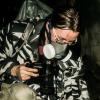Pre rozsirenie obzorov:
(Prepacte, nasledovne sa da prelozit v translate.google.com)
There is more history here than will fit into a post:-) However...
Hypo eliminator is a term used for a solution which converts hypo
into something easily soluble in water. The most effective is Kodak
HE-1 which you mist mix yourself. HE-1 is Hydrogen peroxide hydrolized
with ammonia. It converts the thiosulfate into sulfate, which is
easily washed out. HE-1 was developed by Kodak Labs in the late
1930's. More about this below.
A wash aid is a solution of, basically, 2% Sodium Sulfite. This was
also developed at Kodak Labs partly as a result of investigating sea
water washing.
Its been known for a century that sea water is much more effective
for washing out hypo than fresh water. The sea water must be washed
out afterward since the salts attack the image very vigorously. Sea
water washing became of considerable interest during WW-2 when
photographic materials had to processed on shipboard or elsewhere
there fresh water was at a premium. Kodak wanted to find out how to
duplicate the effectiveness of sea water for washing.
They found that Sodium Sulfite was the most effective salt, in fact,
a properly composed sulfite wash aid is even more effective than sea
water. Plain sulfite works but Kodak found that buffering it to nearly
neutral pH improved its effectiveness by minimising the swelling of
the gelatin, thus minimising the length of the diffusion path the
unwanted chemicals followed in washing. Kodak also added two
sequestering agents to prevent deposits of minerals on the surfaces of
treated film or paper.
Sulfite acts as an ion exchager, in a way similar to the salts in a
water softener. It actually displaces the Thiosulfate ions. It turns
out that it also works on some otherwise insoluble fixer reaction
products.
Hypo Eliminator is effective in removing hypo but does not work on
reaction products. Also, its very alkaline, enough so to damage some
types of emulsions. Since film is easier to wash out than fiber base
paper Hypo Eliminator was recommended for paper only where the
emulsion damage would be inconsequential.
Yet another problem raised its head. In about 1960 T.H.James, of
Kodak Labs discovered that a small residue of hypo left in an emulsion
actually protected the image silver from oxidation! This was such
heresy that the results were not published for a year, in fact not
until after Fuji published similar results.
The amount of hypo must be quite small, larger amounts cause massive
sulfiding of the image causing it to yellow and fade.
Hypo Eliminator was found to be TOO effective, so its use was no
longer recommended except for special instances where absolutely no
hypo was desired.
Wash aid is pretty effective too. The short washing times
recommended by Kodak are so that the protective residue of thiosulfate
will remain in the emulsion.
The two techniques can be used together. Paper treated in Hypo
Eliminator sometimes shows some staining which can be prevented by a
Sulfite or wash aid bath after treating it.
For those interested in experimenting with it Kodak HE-1 is:
Kodak HE-1 Hypo Eliminator
Water 500.0 ml
Hydrogen Peroxide, 3% 125.0 ml
Ammonia, 3% 100.0 ml
Potassium Bromide 1.0 gram
Water to make 1.0 liter
Household Ammonia and drugstore Hydrogen peroxide are about the right
strength. The bromide is very important, it prevents image color
shift.
Treat prints in Kodak Hypo Clearing Agent for three minutes and wash
for ten minutes.
Treat in HE-1 for 6 minutes. Rinse and treat in KHCA again for three
minutes. Wash for twenty minutes.
Other brands of wash aid are all sulfite salts but are not buffered
as is the Kodak product. I think there may be at least one brand which
does not use sulfite but rather a detergent.
Prints treated as above should be toned with sulfide or gold. If not
toned they well be very vulnerable to oxidation by atmospheric
polutants. There is really no advantage to this method other than its
use for some toning treatments where residual hypo may cause bleaching
or staining. For any toner I've ever used a KHCA treatment and
ordinary washing is sufficient.
---
Richard Knoppow
Los Angeles, CA, USA.
![]()























